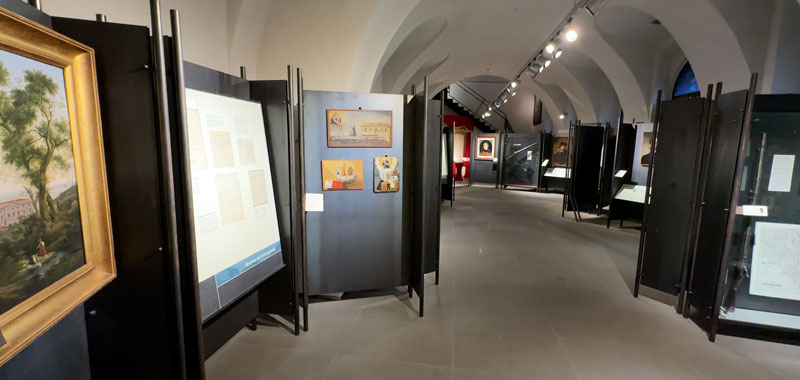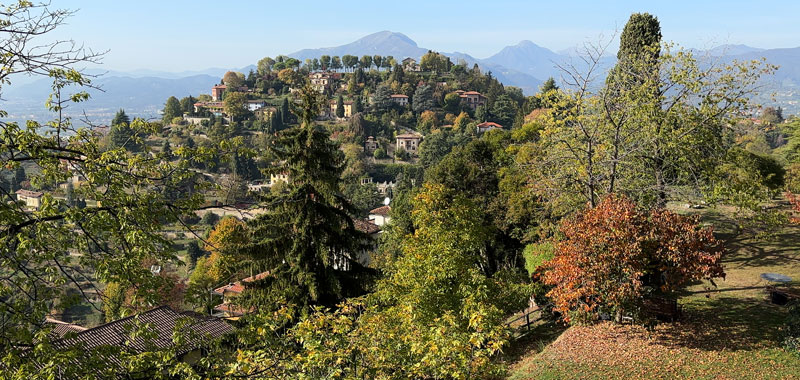
On the east side of town one block from Piazza Mercato Delle Scarpe, you'll reach a 14th-century fortress called La Rocca. It provides some of the best views in town, looking back at the Duomo and other towers from the fort's ramparts, with a nice perspective of the upper town and looking down at the Old Town.

La Rocca served as a fort, prison, refuge and barracks, successfully defeating attacks in 1438 and 1514. The Venetians further fortified it, with construction of a tower and donjon to accommodate the artillerymen.

The interior of the fortress is a history museum, and boasts numerous details, with interplay of walls, arches, and buttresses, set amidst the lush garden greenery. The exhibition is organized in sections and starts with the arrival of the French troops in Bergamo (Christmas 1796). It touches upon, until 1870, the most significant issues related to the events that occurred in the Bergamasque province to Lombard or the national history of Italy.
The goal of the project is to offer a view that is as complete as possible of the 1797-1870 period, through diversified languages and accounts. The exhibition includes reconstructions of settings, multimedia stations, and movable explanatory sheets as well as material accounts taken from both museum collections and from collections belonging to city and provincial institutions or even to private citizens. After undergoing restoration from 1925 to 1927, during which some of the walls and underground structures were demolished, La Rocca took on its current appearance as the Park of Remembrance.

At the other side of town, on the west end, take a funicular ride uphill to the Castello Di San Vigilio. Reach this funicular by walking out through Porta Sant’Alessandro where this visit began when getting off the bus. Continue a block over, outside the city wall, some of which is now encircling a public parking lot. It's a short funicular journey that is well worthwhile because when you get to the top, there will be outstanding views across the city, and there are remains of an old castle.

You could walk up the hill for free, but the round-trip funicular costs under 3 euro, so take that little train and then go out onto the observation terrace for a spectacular view, looking down on the Upper Town from this upper vantage, with the Lower Town beyond spread out into the distance. Then from the funicular walk further uphill a couple blocks to reach the castle.

At this apex of the summit was a large aggregation of old structures which represented the ancient citadel -- that castle of Bergamo which for so many generations had made the city one of the most important fortresses. These are spectacular ruins of a much larger fortress, first built in the 12th century, expanded in the 14th century, and then most of it was blown up by Napoleon.

While most of it is long gone, enough fortified stone ramparts remain to give you the feeling for the power and glory once here. Further enhancing the immersions, you can walk up seveal levels of anciet steps and ladders to reach the graden terrace. It had been the most important fortress of town, protecting Bergamo from attack for many centuries.

The garden terrace is at the apex of the small summit providing 360-degree views all around you. The view from this point is wonderful. Minute, abrupt hills rise out of the many-coloured plain, blue and brown and green.

Behind, the mightier mountains are revealed, rising above the meadows and settlements. It is the background of an early Italian painting, with lines of poplars and mulberry trees, and tall campanili of tiny villages.

When done, it's an easy walk downhill back to the funicular about 300 meters away, passing a small hotel, Relais San Viglio, four stars, with nine rooms, and a beautiful view. Keep your eyes open and your camera ready while going back down and grab a window because you'll have more views all the way to the bottom. The track is 630 meters long and descends 90 meters. This funicular first began operating in 1907.
The entry gate of Porta Sant'Alessandro is just a few dozen steps from the bottom of the funicular, leading you back into the Old Town.
